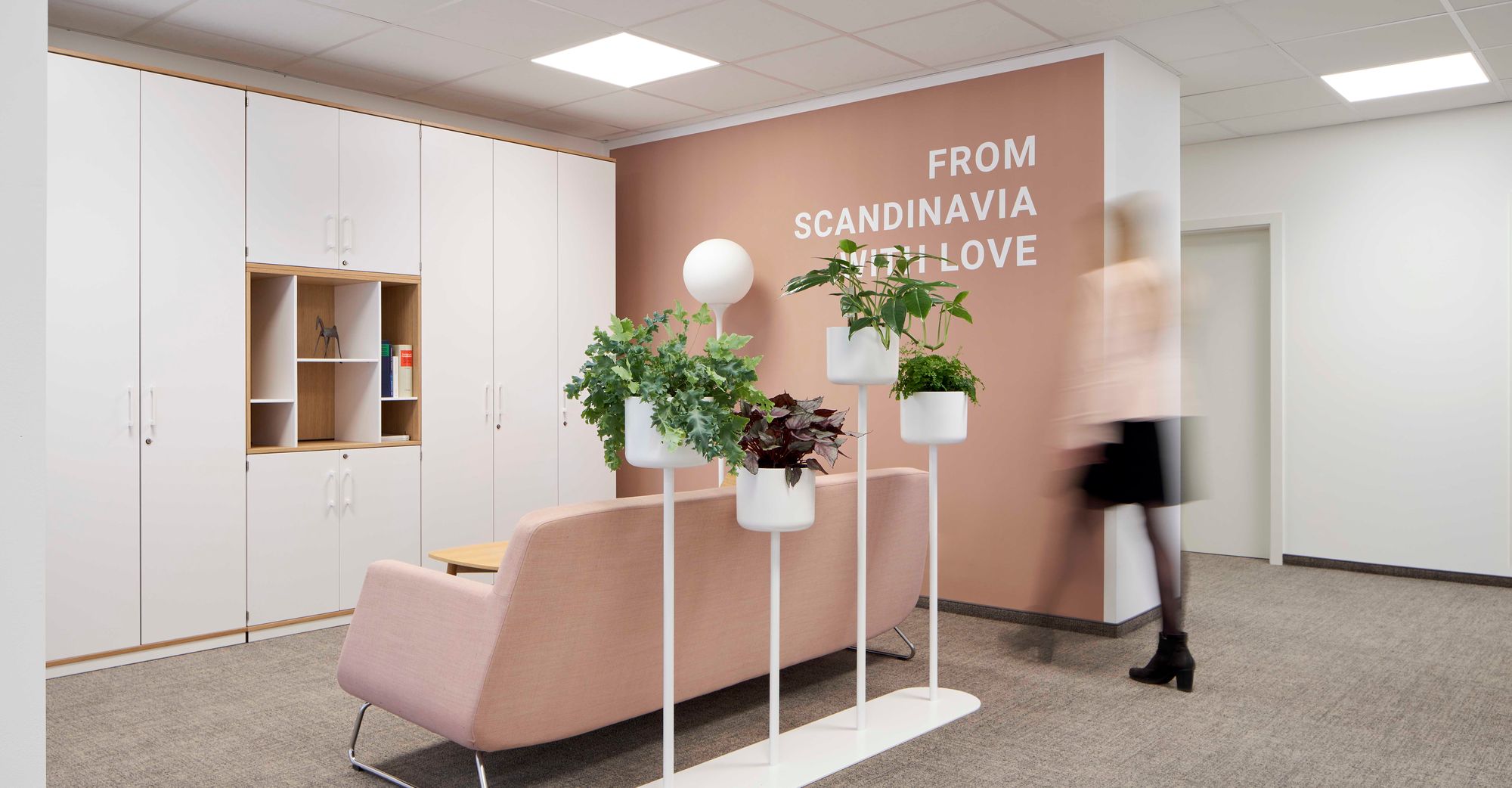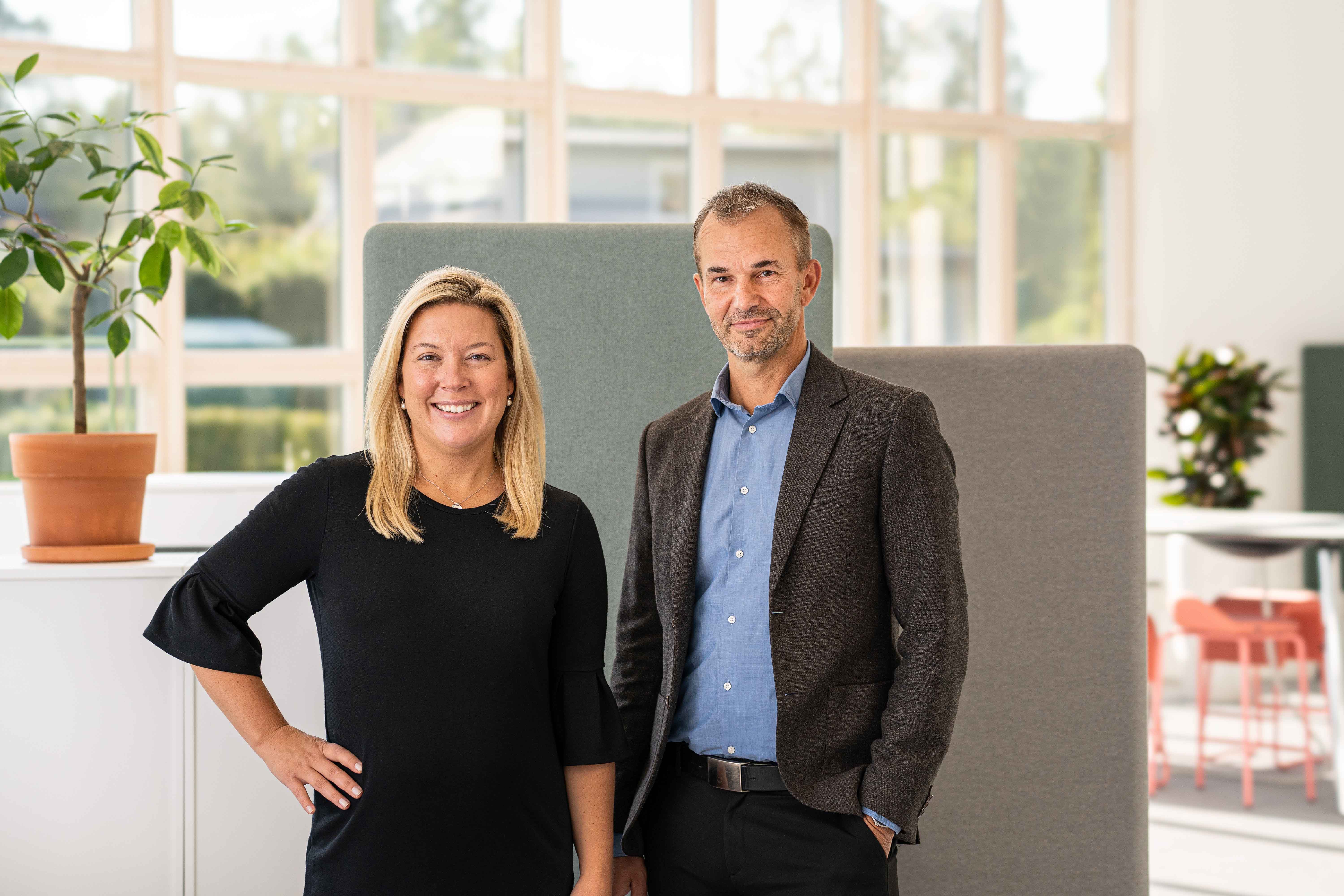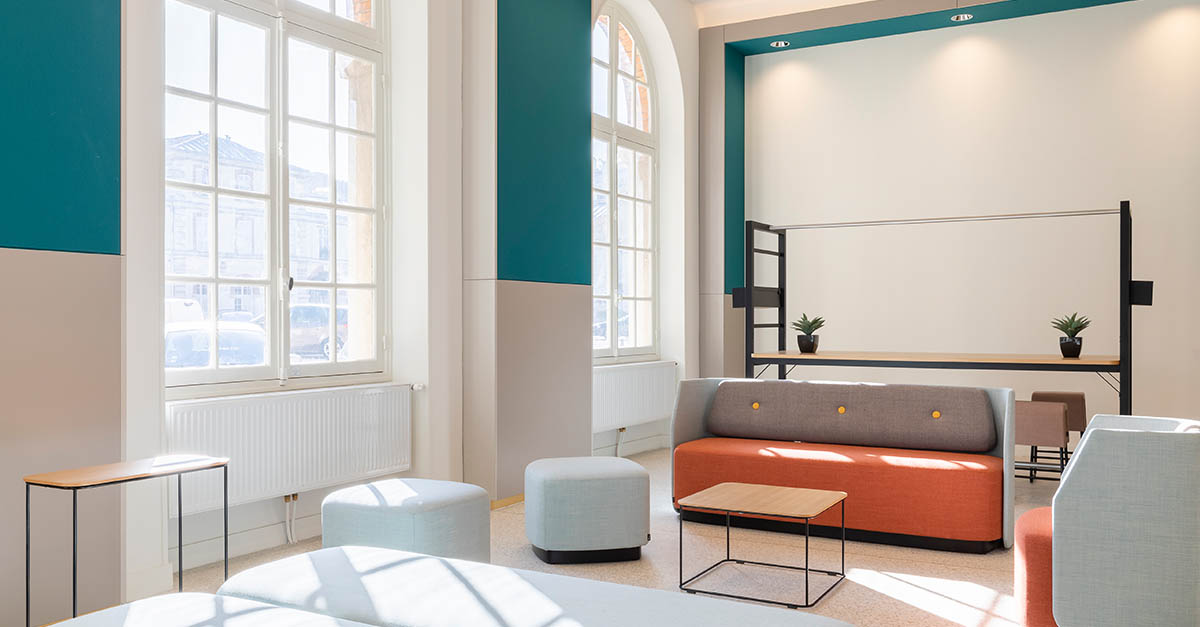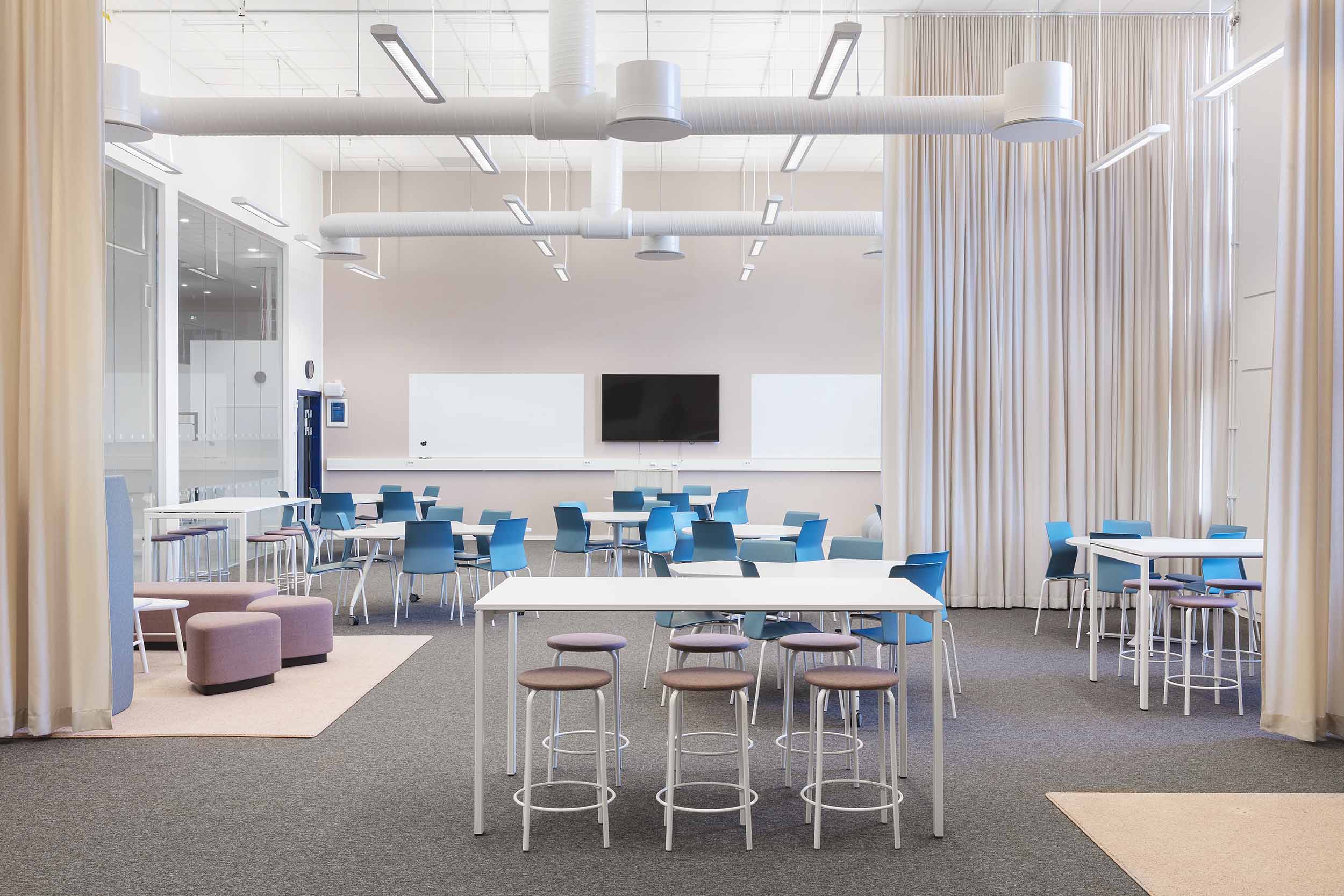
Redefining the workplace - a visionary outlook on the office from Kinnarps
Interior design company Kinnarps originated as a family owned business (and still is to this day) from Sweden - and is now a synonym internationally for ergonomics and quality. We have met with Henrik Axell, Workplace strategist, and Johanna Walden, Brand and concept marketing manager, to hear their thoughts on how we can redefine the workplace post-pandemic.
DURABLE AND ENDURABLE
Founded in 1942, by married couple Jarl and Evy Andersson, Kinnarps AB began producing interior design solutions for public spaces. Today, almost 80 years later, the guiding values from Jarl and Evy lives on; to create sustainable and ergonomic environments for the people using it.
As in other segments of society, there have been some milestones and trends in the world of the office spaces as well. The interior fitting of the room has varied from single office spaces, to office landscapes and “flex offices”. Together with inventions, such as the sit-and-stand table, interior design and ergonomics has been an interesting topic for all organisations operating in public spaces for quite some time.
– We have always been very far ahead in ergonomics, and it is one of the corner stones in our workplace analysis Next Office® that we have developed since many years back, says Henrik Axell, Workplace strategist at Kinnarps. What I think is the biggest difference, in this paradigm shift we are experiencing, is that technology allows us to be space-independent. Fifteen years ago we were tied to a desk, but now technology has made it possible for us to choose the optimal work environment based on which work activity I am to perform. It is a huge development, that you can choose a place and access all your material from there.
CHANGING THE VOCABULARY
When times are changing, so is semantics. Concepts and values need to adapt to present prerequisites, in order to stay relevant. Kinnarps know this, and has altered the vocabulary accordingly. Henrik Axell explains;
– A few years ago, the word workplace was very much associated with the desk. The workplace today is all the environments in the office. When we plan offices today, instead of talking of a "meeting room", we talk about a "meeting space”. We want to introduce the idea that you can have meetings in open spaces, which can be delimited with the help of textiles or partitioning storage, screens or highbacked sofas.
If you come to work, it is so much more appealing to see your colleagues, than for everyone to be trapped inside small rooms.
The open spaces also allows different departments of the organization to interact more freely, contributing to a more inclusive workplace culture. It is also a possibility to adapt to quick changes in the daily operations.
– This is why going from “room” to “space” is an illustrative way of describing this way of regarding the workplace, says Johanna Walden. If the interior design solution is well planned from the beginning, according to mapped needs and way of working, to be able to change and adapt, then we have a much more sustainable and future proof work environment. And it is also good for the people who will work there, because you can alter according to changing needs.
ANALYSING THE OFFICE
So, how can an organisation or business design their interior for best possible outcome for their staff and operations? Is there a general solution that will fix it all? The answer is, no – you must first know your needs. Luckily, Kinnarps can help you.
– Our workplace analysis Next Office® is the tool we use to help our clients make the best investment, says Henrik Axell. It is a thorough process that we have applied on over 250 different office clients internationally. The path to our customers' new office is relatively similar, but the results vary a lot. We start with a well-established methodology where we talk about vision and goals with the management, what will this company do and how will they do it?
A great part of the process is to get the staff informed and involved in a well-planned and thought out way in the different stages of the progression.
– We clearly, together with the client, state the different phases of the process where different groups of the staff will get information; in which channel and at what time, says Johanna Walden. Because, very often – this is not just about furniture, a redecoration of this sort can also mean new ways of working and new routines. For that you need a long-term plan to make the staff comprehend why this is important, and get them onboard. Involving in this case is not about choosing colour on your desk, it is to have a very structured and clear plan for all employees about the goals of the new environments and what possiblities they hold.
A common obstacle when working with interior design is the will from the client to jump to the solution at once, and start decorating immediately - instead of analysing the needs of the company first.
– We do love the enthusiasm, says Henrik Axell. But for us, we want to emphasise the farsightedness and create a sustainable solution that helps the operations and staff in the long run. Not start with picking the colour for the walls, that is the icing on the cake.
BACK TO THE FUTURE?
The past year, many organisations and businesses has worked totally or partially from home, with all the challenges and advantages that may include. This has created a debate on whether or not to have an office space at all, with different pros and cons supporting the opposite sides. The most likely scenario is to have a mix between the two; with a flexible way of working where the office is the central hub for cooperation, creativity and, not the least, nurturing the culture of the organisation. Henrik Axell develops;
– The pandemic has really made us reflect on what we should have the office for. We believe it will be just as important as it was before the pandemic. It is a place to meet your co-workers for collaborations, and a place for high focus work in privacy. The office should be the optimal environment for both. It’s all about identifying what kind of environments your specific business needs.
Not only is the flexible and adapted solution important on the road ahead. So is sustainability.
Johanna Walden explains:
– Something that warms our heart is that we are starting to see a shift in how public environments is procured nowadays, at least in Scandinavia. Previously there has been a strong focus on price, but now we see other types of evaluation parameters such as durability, flexibility and ergonomics. I believe that this is an indication that society actually value other things than economics and understand that they need to see the total life cycle cost instead of the price right here and now.
So with this stated, does Kinnarps have an answer on how the utopian workplace of the future looks?
– Yes, I think it's very simple! says Henrik Axell with a smile. There is not one utopian office, but many and they are designed according to each unique organisation’s well-mapped needs. And if you keep flexibility, sustainability and ergonomics in mind while planning it - you will get a really good office.
TEXT MARIA VÅRENIUS
PHOTO KINNARPS
Related News

Melanopic lux: lighting for education influenced by human biology
Light is essential in our daily lives, influencing our ability to see, overall well-being and performance. In educational environments, lighting quality can significantly impact students' focus, mood, and energy levels. So, how do we know what is the right amount and quality of light for this setting? Traditionally, light has been measured in lux, a unit of measurement for the intensity of light. It's used to measure how much light falls on a surface or the amount of light in a given space. One lux is the amount of light that falls on a surface that is one square meter in area when one lumen of light is spread out evenly. Recent advancements in research have unveiled the importance of melanopic lux, which goes beyond mere visibility. This measures how effectively light stimulates specific eye cells that regulate crucial non-visual functions such as sleep and alertness. In classrooms and lecture theatres, the melanopic ratio has become vital in lighting design, enabling educators to create spaces that support visual tasks and align with students' biological rhythms. In this article, we explore how lighting solutions can align with our biology, and how this helps to create optimum conditions for educational environments. The science of vision and light The human eye is a remarkable organ designed for high-resolution colour vision within a small area (approximately 2 degrees of the visual field) while relying on peripheral vision for motion detection. This dual-function system, shaped by evolution for survival, continues to influence how we perceive and interact with our surroundings. Our eyes are particularly susceptible to green and yellow light, reflecting our evolutionary adaptation to naturally lit environments. In contrast, blue light, which is chief in modern LED lighting, requires higher intensity to be perceived at the same level. Effective lighting design carefully considers brightness, timing, and distribution to support visual clarity and biological functions like mood and alertness. For example, exposure to bright light in the morning helps regulate circadian rhythms, boosting alertness and mitigating the effects of seasonal darkness. This is particularly important in educational environments, such as schools and universities, where lighting impacts mood, focus, and overall performance. Our Organic Response system provides an innovative solution tailored for these spaces. This smart lighting technology automatically optimises light levels, featuring daylight-responsive sensors and advanced occupancy detection, maintaining a balance between natural and artificial light. Doing so supports visual comfort and reduces energy consumption, making it an ideal choice for creating dynamic, efficient, and student-friendly learning environments. To further support students, well-lit spaces with minimal glare are essential for reducing eye strain and maintaining focus during extended study sessions. Adjusting light intensity and colour temperature for different tasks—such as reading, group discussions, or creative activities—enhances light's visual and non-visual effects. By integrating thoughtful lighting strategies like those offered by Organic Response, educational environments can promote healthier, more productive, and engaging learning experiences. Integrative lighting: Supporting health and well-being. Integrative lighting (also referred to as human-centred lighting) combines visual and non-visual benefits (such as emotional effects) to support biological rhythms and psychological well-being. This approach goes beyond traditional lighting solutions by considering how light impacts circadian rhythms and hormonal balance. Light exposure in the morning is critical for suppressing melatonin (the sleep hormone) and increasing cortisol (the alertness hormone). Proper timing helps align students' natural rhythms with school schedules, which often require a lot of focus. Consistent exposure to bright, cool light early in the day can enhance energy levels and cognitive performance. The melanopic ratio compares the spectral composition of a light source with daylight. Using this information, you can determine its melanopic lighting intensity. This enables the design of lighting setups that precisely meet both visual and biological lighting needs. Lighting recommendations for educational spaces Each learning environment has unique lighting needs. Libraries benefit from direct lighting on the floor, paired with ambient lighting on walls and ceilings. Vertical shelf lighting (200-300 lx) makes it easier to browse titles. Lecture halls, on the other hand, require glare-free, comfortable lighting with flexible control, ideally with pre-programmed scenarios. In auditoriums and classrooms, strong vertical lighting is crucial for clear visual communication, especially over greater distances, enhancing facial expressions and engagement. General lighting recommendations apply to all educational spaces. Our solutions meet industry standards, ensuring reading and writing areas maintain 500 lx for effective visual tasks. Using daylight-responsive sensors for luminaire rows can reduce energy consumption while maximising natural light. The number and arrangement of luminaires should be adjusted based on the room's size and function to ensure consistent illumination. The role of dynamic lighting A Double Dynamic lighting system can be a game-changer in educational environments. It allows for intensity and colour temperature adjustments to match the specific needs of activities, from quiet reading sessions to collaborative group work. Fagerhult's distinct approach to lighting means that our design is human-centric; we integrate scientific insight into light and human psychology, creating environments that support academic performance and well-being. Our focus on energy efficiency also means our advanced control systems optimise light usage while minimising energy consumption, contributing to a building’s sustainability goals. The customisable setting and flexible solutions ensure that educational environments can create tailored lighting profiles for different times of the day or specific learning activities. Long-term benefits of melanopic lighting Melanopic lighting, designed to mimic the natural light spectrum, helps regulate the circadian rhythm, which is essential for maintaining focus, energy, and emotional balance. In classrooms and study areas, proper lighting can reduce eye strain, improve sleep patterns, and enhance mood, which are critical for students' mental health and academic performance. By incorporating lighting that aligns with our biological needs, schools and universities can foster healthier, more productive learning environments,. This is particularly important during the winter months when daylight is limited. Whether through advanced tuneable white light systems, designs that maximise daylight, or energy-efficient solutions, we are dedicated to leading the way in lighting innovation for educational environments, delivering brighter futures—one classroom at a time.
The inspiration behind Nobel Week Lights: ”Light, art and technology intertwined.”
Nobel Week Lights has quickly become a beloved public celebration. During Nobel Week, Stockholm residents flock outdoors to marvel at the spectacular light installations, where contemporary lighting technology meets artistic expression. ”We aim to create a moment of gathering: around light and around something meaningful”, says Lara Szabo Greisman. Nobel Week Lights is a light festival that illuminates Stockholm during the darkest time of the year – a free cultural experience for everyone. Presented by the Nobel Prize Museum, the festival invites international and local artists, designers and students to create light artworks inspired by the Nobel Prize. The installations shed new light on the scientific discoveries, literature and peace efforts of Nobel laureates while offering a fresh perspective on the city. Fagerhult is Principal Partner of Nobel Week Lights 2024, and this year’s edition features 16 different light installations across Stockholm. The artworks can be experienced from 7–15 December, including ”The Wave”, a light installation by the art collective Vertigo, located in front of the Parliament House where visitors can walk right through the luminous wave. The Wave by Vertigo ”Light and art and creativity is incredibly intertwined because these are technologies that are constantly evolving. So part of the fun working with the artists is that they are constantly testing new technologies. And we see these incredible visual results which are based on just pure innovation”, says Lara Szabo Greisman, co-founder and producer of Nobel Week Lights. Lara Lara Szabo Greisman and Leading Lights by Les Ateliers BK The significance of light as a collective force, its ability to encapsulate life and death, joy and sorrow – indeed, the very essence of what it means to be human – makes lighting a powerful medium of artistic expression, she argues: ”The dream for the festival is that this becomes a personal experience for each and every member of the audience. A moment that they remember and cherish . A moment that they think about later and bring forward as their story of connecting with the city.”


